So, it’s almost done.
-
@Remittancegirl At the risk of opening a bottomless rabbit hole, what did we do to wash silk before dry-cleaning? I’m guessing we had several thousand years of silk clothes before this was an option.
@erik I don’t know what they did in Europe. In Japan they would completely unpick the kimono, sew it back into a full bolt, with the bits stitched together with whip stitches and join it in a giant belt, and they had a mechanical machine like a spinner that ran a single layer over a huge vat of steaming water. It took about 3 hours of the belt of silk rotating over the vat to get it clean. Then someone would dry it indoors, and sew the kimono back together.
-
@Remittancegirl At the risk of opening a bottomless rabbit hole, what did we do to wash silk before dry-cleaning? I’m guessing we had several thousand years of silk clothes before this was an option.
@erik @Remittancegirl for western clothes (because that's what I know best) one option was simply not washing them
you usually wore at least one layer (often two) of sturdy, white-ish linen close to the skin, and that got washed regularly with the harsh methods in use back then (boiling and beating), while the outer layers only got brushed and aired out
of course one wouldn't wear their fancy silk clothing while doing dirty work of any kind, and other clothes were protected with aprons and other strategically placed items (e.g. sleeve protectors when writing or doing other office work).
to be fair, at the end of the season your fancy clothing could at times end up being unpicked and re-dyed, which I assume involved some kind of washing (and any stained part could be avoided when reusing the fabric to remake a different looking dress).
-
@erik @Remittancegirl for western clothes (because that's what I know best) one option was simply not washing them
you usually wore at least one layer (often two) of sturdy, white-ish linen close to the skin, and that got washed regularly with the harsh methods in use back then (boiling and beating), while the outer layers only got brushed and aired out
of course one wouldn't wear their fancy silk clothing while doing dirty work of any kind, and other clothes were protected with aprons and other strategically placed items (e.g. sleeve protectors when writing or doing other office work).
to be fair, at the end of the season your fancy clothing could at times end up being unpicked and re-dyed, which I assume involved some kind of washing (and any stained part could be avoided when reusing the fabric to remake a different looking dress).
@Remittancegirl @erik also, as long as you're using a protein-safe detergent (i.e. no enzymes, and acidic rather than alkaline) a lot of silks can go quite safely in the washing machine, especially on a delicates cycle.
others can go in the washing machine and remain usable, but they change properties (so it depends on whether the garment you're making needs those properties)
sartorbohemia.com/article/14/h… ----> this is a shop that tested the fabric they sell and there are a lot of details
-
@erik I don’t know what they did in Europe. In Japan they would completely unpick the kimono, sew it back into a full bolt, with the bits stitched together with whip stitches and join it in a giant belt, and they had a mechanical machine like a spinner that ran a single layer over a huge vat of steaming water. It took about 3 hours of the belt of silk rotating over the vat to get it clean. Then someone would dry it indoors, and sew the kimono back together.
@Remittancegirl @erik do you know if they were also wearing an under layer (I believe they did) that was easier to wash and washed more often (here I have no idea), or if that was the procedure for every kind of garment? -
@Remittancegirl @erik do you know if they were also wearing an under layer (I believe they did) that was easier to wash and washed more often (here I have no idea), or if that was the procedure for every kind of garment?
@valhalla But also, kimonos all have what is called a tomo eri : ‘a collar’s friend’. It is sewn on top of the collar of the kimono, and can be removed once it is too worn or soiled, to reveal a pristine new collar! Because the neck is where the garment would normally get the most contact with the neck. @erik
-
@valhalla But also, kimonos all have what is called a tomo eri : ‘a collar’s friend’. It is sewn on top of the collar of the kimono, and can be removed once it is too worn or soiled, to reveal a pristine new collar! Because the neck is where the garment would normally get the most contact with the neck. @erik
@Remittancegirl @erik exactly the reason why people used detachable collars on shirts in the west! -
So, it’s almost done. The last and trickiest thing is left to do - sew on the collar, which needs to be done by hand.
I’m still not sure about the seam pockets. They went in easily, but they’re fucking with the line of the garment. If you look closely at the side seam, it’s sagging a bit. Probably not going to be obvious when it’s worn, but still. I’m wondering if it would be better to pull them out and make front patch pockets instead. What do you think?
#Sewing@Remittancegirl
This is not Japanese but a similar pattern. It is needlecord over-printed on, what looks like, a cushion design, some of which shows through.
It's a very useful jacket -
@Remittancegirl
This is not Japanese but a similar pattern. It is needlecord over-printed on, what looks like, a cushion design, some of which shows through.
It's a very useful jacket@HeatherMJ BTW, I really love the way the sides and hem are finished off!
-
@HeatherMJ BTW, I really love the way the sides and hem are finished off!
@Remittancegirl
The pattern suggested three different ways of finishing the seams. I'd never heard of a Hong Kong finish before, but I'm really pleased I chose it -
@Remittancegirl
The pattern suggested three different ways of finishing the seams. I'd never heard of a Hong Kong finish before, but I'm really pleased I chose it@HeatherMJ Is that using bias binding on the raw edges?
-
@HeatherMJ Is that using bias binding on the raw edges?
@Remittancegirl
That's the one. It's a good finish. -
@Remittancegirl
That's the one. It's a good finish.@HeatherMJ @Remittancegirl I love that finish for non-thin fabric!
Unless it's on really thick fabric I prefer to use self-made bias from a lighter fabric than what is usually used for bought bias tape, however.

